- In Southeast Asian countries of Thailand, Cambodia, Vietnam and Japan Hindu and Buddhist cultures are intertwined thanks to Indic culture and Temples not to forget Ramayana’s role.
For a while now, perhaps starting
British rule Hinduism and Buddhism are pitted against each other in India. With
Neo-Buddhists (called Ambedkarites, one who became Buddhists post 1956) the
animosity is higher.
However, when I visited Thailand faced
no such animosity. In fact, during my 1998 Kailash Yatra the Tibetan who ran a
small guest-house during the route was delighted to host Indians and treated us
very well. Art historian and film-maker Benoy K Behl
wrote in The Indian
Roots of Tibetan Buddhism, “In the words of H. H. the Dalai Lama in the film: “Tibetan script is very much a copy and very much similar to Sanskrit.” Another Indic scholar Sanjay Rao wrote Harmonious
blend of Hindu, Buddhist and Shinto strains in Japan
This goaded me into presenting this photo feature. It is presented country-wise and includes Myanmar.
1.
Thailand
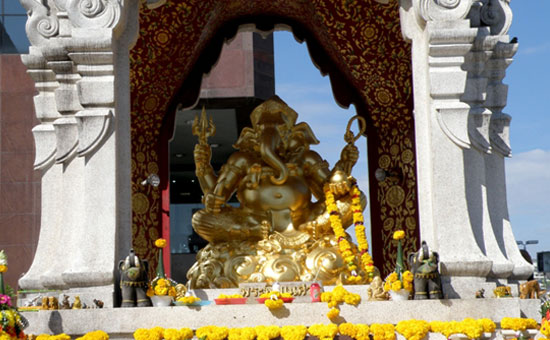 Ganesha Temple near Sukumwit Street, Bangkok. Pic 2009.
Ganesha Temple near Sukumwit Street, Bangkok. Pic 2009.
However, Ganesha is
worshipped as Lord of Love unlike India where he is the remover of obstacles.
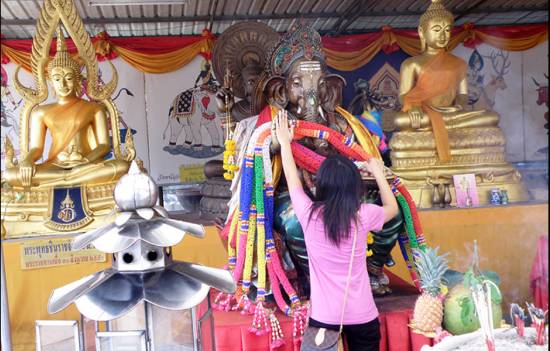 A Thai girl outside Wat Phanancherng, Ayutthaya i.e. before she entered the Wat. Pic 2009.
A Thai girl outside Wat Phanancherng, Ayutthaya i.e. before she entered the Wat. Pic 2009.
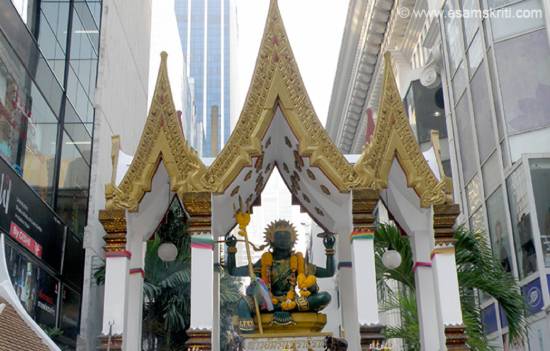 Indra Temple on Sukumwit Street, Bangkok. Pic 2009.
Indra Temple on Sukumwit Street, Bangkok. Pic 2009.
It is next to a Brahma Temple and attracts large number of Thai devotees. The brochure of the Siam Niramit-cultural show held in Bangkok states “Ascend to Daow-wa-dueng, the second level of heaven, where Indra, the greatest deity of all presides.”
In India we treat Indra as a Hindu God so was left wondering. When I asked this question to culture historian Benoy K Behl he said, “The earliest-known representation of Lord Indra is of the 2nd century BCE in the Buddhist caves of Bhaja in Maharashtra. Indra continues to be in worship in every Buddhist temple of Japan. Please see my book, Hindu Deities Worshipped in
Japan. In ancient times, there were no separate religions of Hinduism and Buddhism in India.” Bhaja Caves were made around 2nd century
BCE.
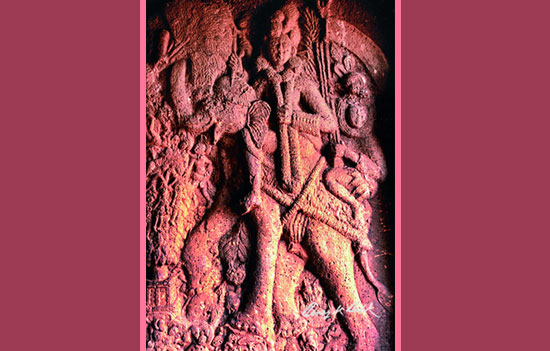 Earliest depiction of
Lord Indra in Bhaja Cave, Maharashtra. Pic Benoy K Behl.
Earliest depiction of
Lord Indra in Bhaja Cave, Maharashtra. Pic Benoy K Behl.
Well-known
author Devdutt Patnaik wrote in Mumbai Mirror, “In Buddhist lore, he is present when the Buddha is born and when the Buddha becomes the Buddha, i.e. attains enlightenment and he encourages Buddha to spread his wisdom to humanity.”
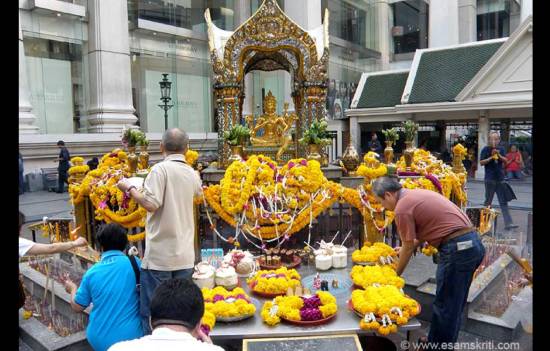 Brahma Temple, local name Erawan Shrine is on Sukumwit Street, Bangkok.
Brahma Temple, local name Erawan Shrine is on Sukumwit Street, Bangkok.
It is close to Central World, Chidlam
station and is a Lord Brahma shrine. Board says it is Thao Maha Brahma. Thai
Buddhist tradition associates Lord Brahma with creation.
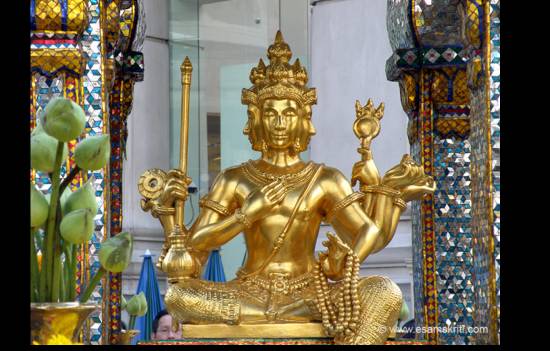 Close up of Brahma. Pic 2009.
Close up of Brahma. Pic 2009.
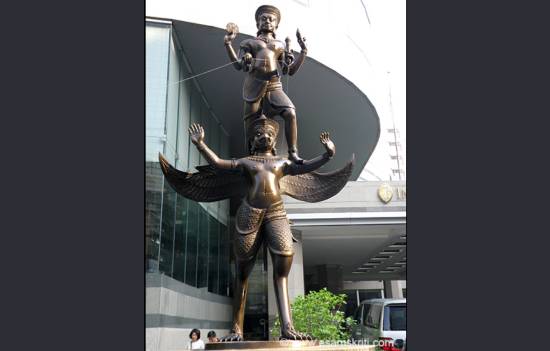 Close by is Inter Continental Hotel where you see Garuda and Lord Vishnu's image. Pic 2009.
Close by is Inter Continental Hotel where you see Garuda and Lord Vishnu's image. Pic 2009.
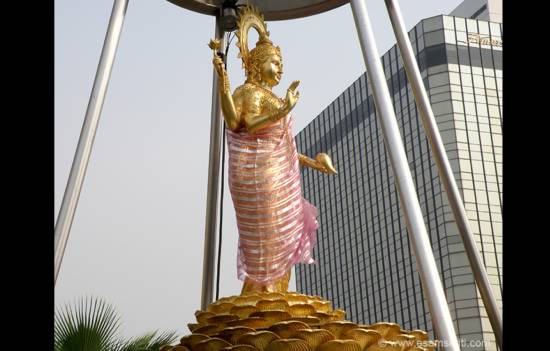 Opposite the Erawan shrine, placed on the terrace garden of Gaysorn Plaza is an image of Goddess Lakshmi (wealth). Pic 2009.
Opposite the Erawan shrine, placed on the terrace garden of Gaysorn Plaza is an image of Goddess Lakshmi (wealth). Pic 2009.
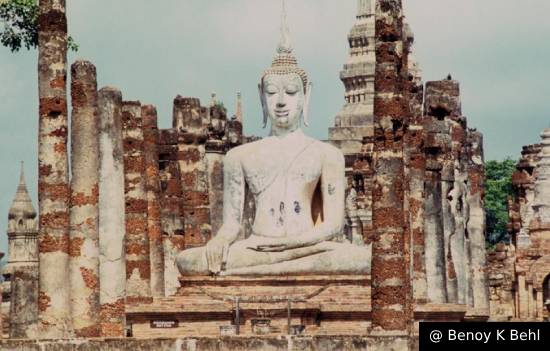 Buddha at Sukhothai Historical Park. Pic by Benoy Behl.
Buddha at Sukhothai Historical Park. Pic by Benoy Behl.
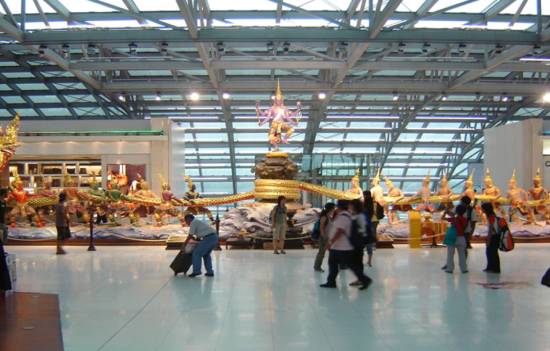 Sagar Manthan or Churning of the Milk Ocean at Bangkok Airport.
Sagar Manthan or Churning of the Milk Ocean at Bangkok Airport.
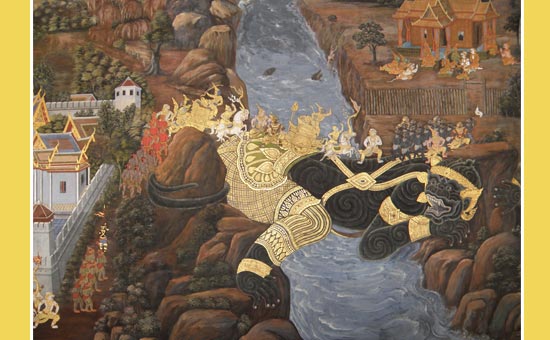 The walls of the complex of Emerald Buddha have murals of the Ramayana. Pic 2009.
The walls of the complex of Emerald Buddha have murals of the Ramayana. Pic 2009.
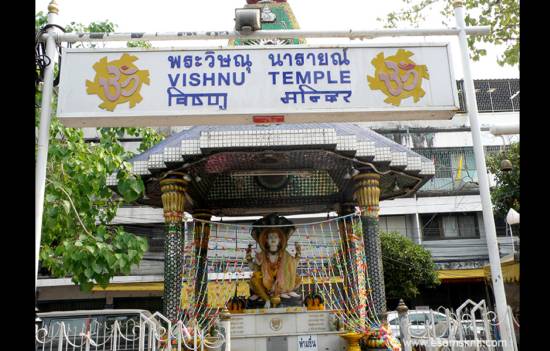 Vishnu Temple, Bangkok. Pic 2009.
Vishnu Temple, Bangkok. Pic 2009.
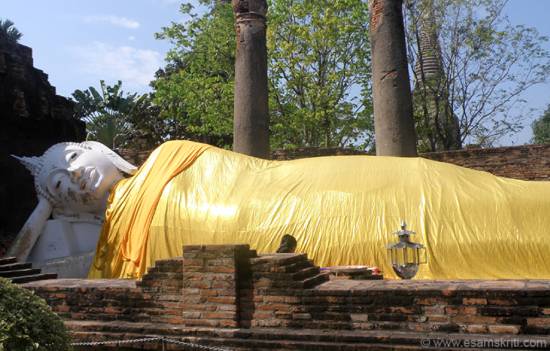 Sleeping Buddha, Ayutthaya. Pic 2009. Ayutthaya was earlier known as ‘Ayothaya’ or the capital of Lord Rama.
Sleeping Buddha, Ayutthaya. Pic 2009. Ayutthaya was earlier known as ‘Ayothaya’ or the capital of Lord Rama.
Albums Hindu Symbols in
Thailand, Hindu Temples in
Bangkok, Ayutthaya
Prof Dr Shashibala Dean, K M Munshi Centre of Indology, Bharatiya
Vidya Bhavan, New Delhi wrote
in
The Statesman, “All the kings of the Chakri Dynasty, Thailand are given the title of "Rama" because Rama was an incarnation of Vishnu - the sustainer of the world. The former King Bhumipol Adulyadej, ruled as Rama 9th. People of all
classes and education levels know the stories from their childhood. King Rama 2nd translated the Indian version of Ramayana into Thai and it is included in school and university curricula.”
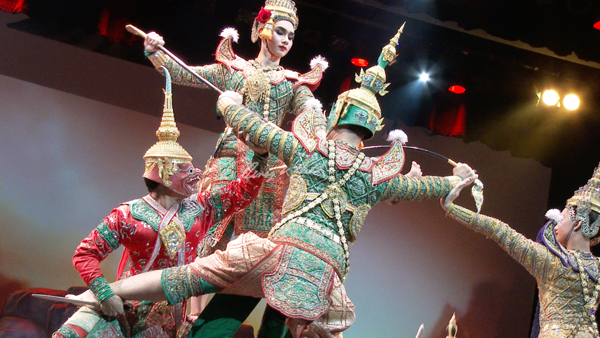 Victorious Rama. Photograph by Benoy K Behl. Sala
Chalermkrung Royal Theatre, Thailand.
Victorious Rama. Photograph by Benoy K Behl. Sala
Chalermkrung Royal Theatre, Thailand.
2. Cambodia
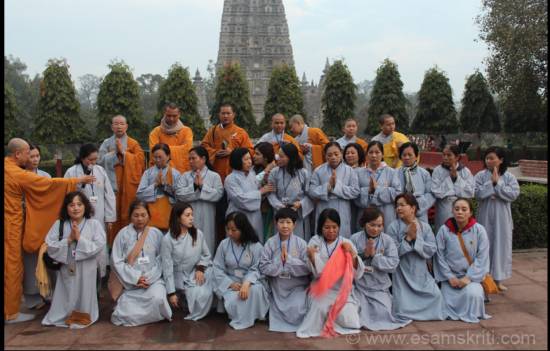 Cambodian Devotees at Bodh Gaya. Pic 2012.
Cambodian Devotees at Bodh Gaya. Pic 2012.
Prof Dr Shashibala wrote, “Hindu religion and culture was practiced during the Khmer Empire in Cambodia. It is mentioned in Cambodian Sanskrit inscriptions that copies of Ramayana, Mahabharata, Puranas and Manusmriti were brought by the Cambodians for recitation in temples.”
Param
Vishnu Lok
or Vrah Vishnuloka (sacred dwelling of Vishnu) was the original name of Angkor
Wat.
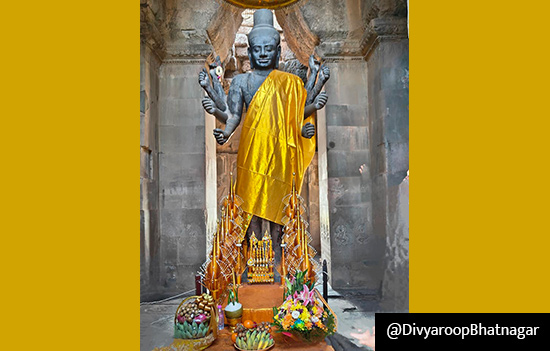 Murti of Vishnu in sanctum at Angkor Wat Temple, Cambodia.
Murti of Vishnu in sanctum at Angkor Wat Temple, Cambodia.
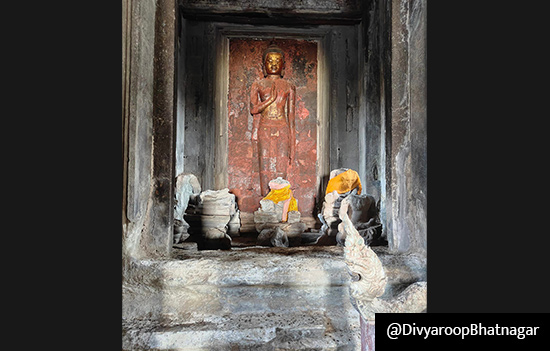 Murti of Buddha replaced Vishnu sanctum at Angkor Wat Temple.
Murti of Buddha replaced Vishnu sanctum at Angkor Wat Temple.
Traveller Divyaroop Bhatnagar who visited Cambodia wrote, “There are enormous galleries each carved with scenes from the Mahabharat and Ramayan and the Amrit Manthan.”
In
Cambodia he added, “We also visited a Buddhist temple on a hill that had statutes of Shiva and Ganesh as well. A Buddhist priest was pouring water over a Shiv Linga and the people were taking the water and pouring it on their heads before worshiping at the Buddhist temple.”
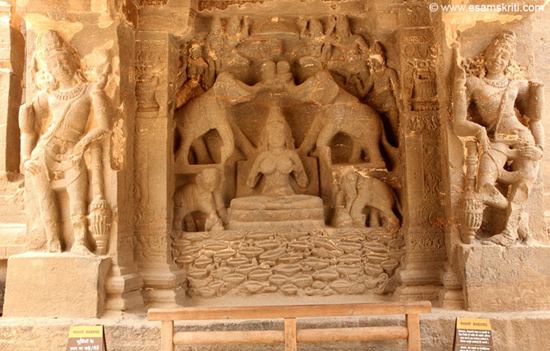 Entrance
Kailasa Temple Ellora. Gajalakshmi seated on a lotus with elephants pour water
by way of ritual adoration.
Entrance
Kailasa Temple Ellora. Gajalakshmi seated on a lotus with elephants pour water
by way of ritual adoration.
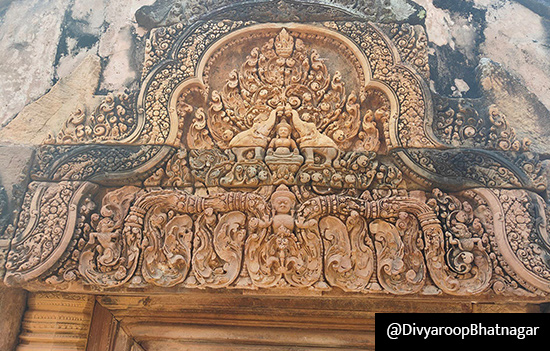 Similar work seen in Cambodia as referred to in previous pic.
Similar work seen in Cambodia as referred to in previous pic.
Nandi is still revered in a Buddhist
state as in this beautiful depiction outside the National Museum.
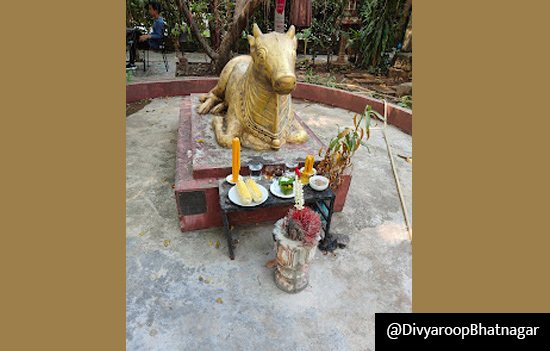 Nandi
Nandi
Architectural
historian and Author Dr Ujjwala Anand
Palusey wrote, “Cambodia’s connection with the Ramayana, locally known as Reamker, is deeply intertwined with its Khmer heritage. The most magnificent depictions of the epic can be found in the Angkor temple complex, particularly in Angkor Wat and the Bayon Temple. The Khmer kings, who saw themselves as divine rulers, commissioned these intricate bas-reliefs to adorn their temples, immortalizing the story in stone.”
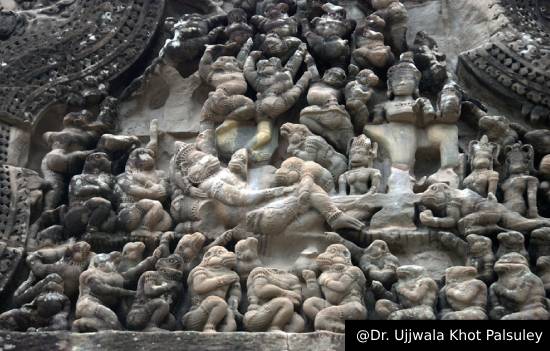 Death of
Vali on the pediment at the Angkor Wat temple.
Death of
Vali on the pediment at the Angkor Wat temple.
She added, “The Banteay Srei
Temple, often referred to as the “jewel of Khmer architecture,” is another remarkable site where the Ramayana is extensively depicted. The temple’s intricate pink sandstone carvings include scenes such as Ravana shaking Mount Kailasa, the battle between Rama and Ravana, and episodes featuring Hanuman’s heroics.”
Further, “Both classical dance
and shadow puppetry play a crucial role in preserving and transmitting the
legacy of the Reamker to future generations, ensuring its enduring presence in Cambodian cultural identity.”
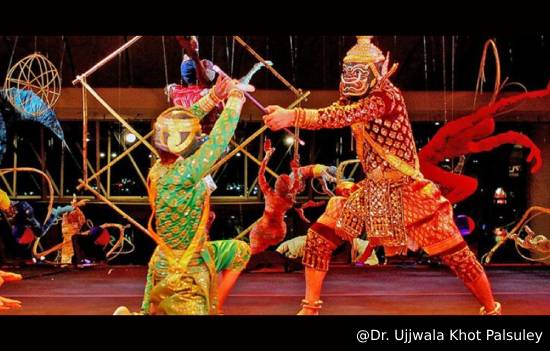 The Khmer Reamker, which follows the protagonist Prince Preah Ream on his quest to rescue his beloved wife Neang Seda from the clutches of the evil giant Reap (Ravana), holds a special place in Cambodian culture.
The Khmer Reamker, which follows the protagonist Prince Preah Ream on his quest to rescue his beloved wife Neang Seda from the clutches of the evil giant Reap (Ravana), holds a special place in Cambodian culture.
3. Vietnam
After visiting My Son Sanctuary in Vietnam Shobhna
Vora wrote, ““The Hindu tower temples of the My Son Sanctuary are located within a well-protected property with clearly defined boundaries. Eight groups of 71 standing monuments exist as well as extensive buried archaeology representing the complete historic sequence of construction of tower temples at the site, covering the entire period of the existence of the Champa Kingdom.”
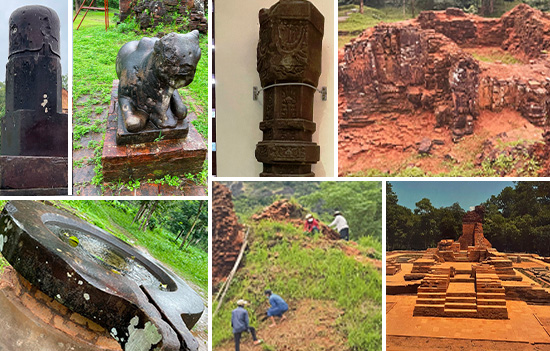 Collage pic of visit to My Son Sanctuary, Vietnam.
Collage pic of visit to My Son Sanctuary, Vietnam.
4. Japan
In Harmonious blend of Hindu,
Buddhist, Shinto strains in Japan Indic scholar Sanjay Rao wrote, “In ancient Japanese Buddhism, Hindu Deities are revered and given their place of respect in the Buddhist realm of deities. The Hindu deities are considered guardian Deities of the Buddhist concept of the ‘Clear Mind Buddha’. The ‘Clear Mind Buddha’ who is pristine and pure in thought (Nirgun as the Hindus say) however, is the primordial state without beginning or end and is the state which all humans must aspire to achieve to get salvation from rebirth.”
“In the next few frames , I shall post pictures of some of the critical Hindu “Guardian Deities “ that have been exhibited in the Great 120 meter hall, which is 900 years old. These Guardian deities stand on either side of the Avalokiteshwara Deity (The Buddhist God of compassion) and in front of the 1000 Kannons. The Hindu deities don’t resemble the Indian versions as there were conceptually transplanted about 900 years ago and are carved based on Japanese interpretations of Indian and Chinese Sutras.”
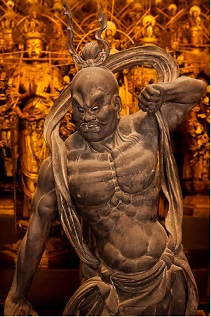 Japanese Name: Naraen Kengo, Sanskrit: Narayana.
Japanese Name: Naraen Kengo, Sanskrit: Narayana.
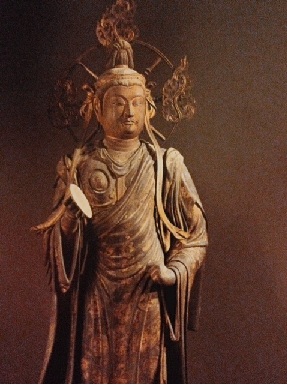 Japanese Name: Taishaku-ten Sanskrit: Indira.
Japanese Name: Taishaku-ten Sanskrit: Indira.
Culture historian and photographer made
a movie Hindu Deities in Japan. He wrote, “In many ways, I find that Japan has preserved
ancient Indian traditions, even when they may have changed here in India. As an
instance, in Japan, Saraswati is depicted
and venerated not only with the Veena, but also remembered for her association
with water. (One may recall that Saraswati is originally the personification of
the river by that name.) Therefore, she is also worshiped in pools of water in
Japan.
The 6th
century Siddham script is preserved in Japan, though we do not use it in India. ‘Beejaksharas’ of Sanskrit in this script are regarded as holy and are given great importance. Each deity has a ‘Beejakshara’ and these are venerated by the people, even though most of them cannot read it.
Many
links in the development of Vajrayana Buddhism can be found in a study of
Japanese Buddhism. Today’s Himalayan Buddhism is of a later development and has lost the typical ‘havan’ or ‘homa’. I was delighted to find and to record the continuance of the tradition of ‘homa’ in some of the most important Japanese Buddhist sects, who call it ‘goma’. Sanskrit sutras are also chanted on the occasion and it is much like the ‘havan’ which we are all familiar with.”
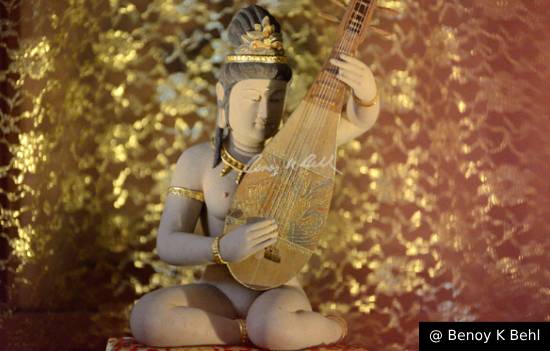 Saraswati, or Benzaiten, Yoshiwara Jinja, Tokyo. Photograph by Benoy K Behl
Saraswati, or Benzaiten, Yoshiwara Jinja, Tokyo. Photograph by Benoy K Behl
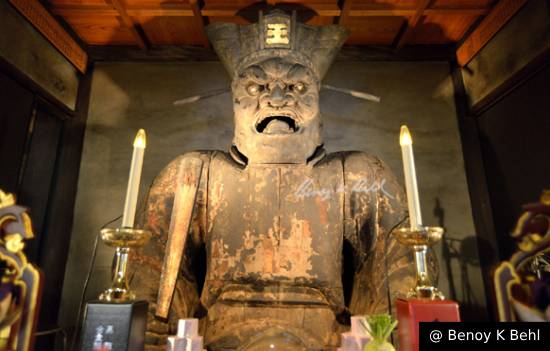 Yama, or Emma, Inoji, Kyoto. Photograph by Benoy K Behl
Yama, or Emma, Inoji, Kyoto. Photograph by Benoy K Behl
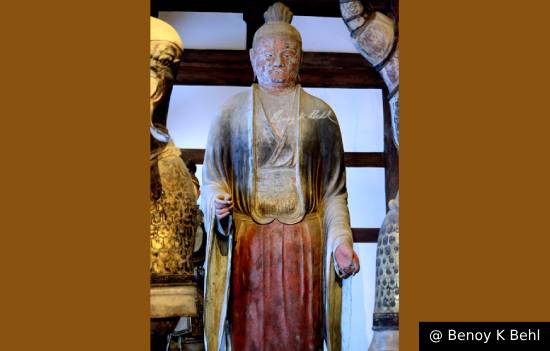 Brahma, or Bonten, Todaiji Temple, Hokkedo Hall, Nara. Photograph by Benoy K Behl.
Brahma, or Bonten, Todaiji Temple, Hokkedo Hall, Nara. Photograph by Benoy K Behl.
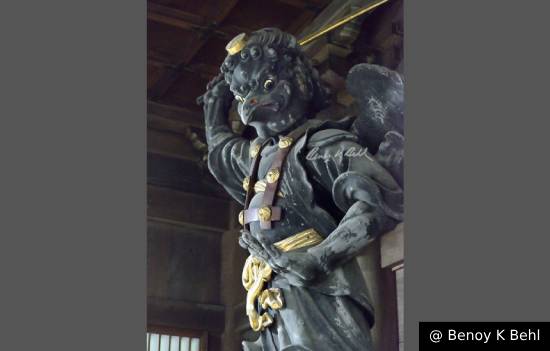 Garuda, or Karura, Daiyuzan-Saijoji, near Odawara. Photograph by Benoy K
Garuda, or Karura, Daiyuzan-Saijoji, near Odawara. Photograph by Benoy K
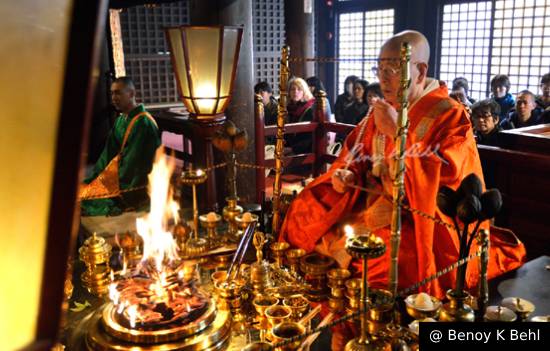 Havan or Homa, or Goma in Japan, Takahata Fudo Temple, Tokyo. Photograph by Benoy K Behl.
Havan or Homa, or Goma in Japan, Takahata Fudo Temple, Tokyo. Photograph by Benoy K Behl.
Benoy Behl also wrote, “Goma in the Shingon and Tendai Buddhist sects of Japan has striking parallels with the early Hindu rites of Agni worship. There are also deep
similarities with the later Tantric traditions. The havan is perhaps conducted in Japan, at least as often as in India. The tantric Shingon school of Japan sings Sanskrit hymns. To this day, followers of the sect perform their worship in 1,200 temples throughout Japan. In the words of His Excellency Mr. Yasukuni Enoki, Former Ambassador of Japan: “This should be recognized by the Japanese people that at the bottom of Japanese culture, Indian culture is very strongly imprinted. It is then developed in the Japanese way.”
Also see film Hindu
Deities Worshipped in Japan
by art historian Benoy K Behl or to buy his book
online
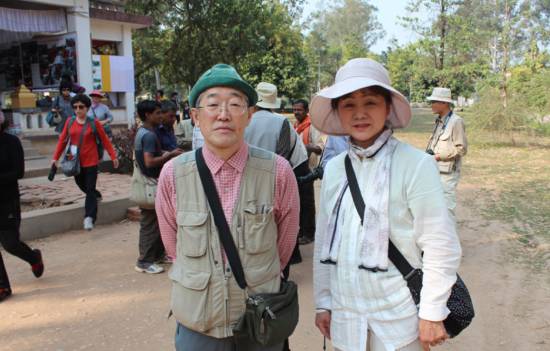 Japanese Couple at Rajgir. 2012.
Japanese Couple at Rajgir. 2012.
5. Myanmar
Prof Dr Shashibala wrote, “The oral
tradition of the Rama story can be traced as far back as the reign of King
Anawrahta (A.D.1044-77), the founder of the first Myanmar Empire. In later
periods there are ample archaeological, historical and literary evidence to
show that Ramayana entered into Myanmar culture at an early date. At old Bagan
is a Vishnu Temple known as Nat Hlaung
Kyaung which is adorned with some stone figures of Rama and Parasu Rama. The Rama story is depicted in the Jataka series of terra-cotta plaques on the panels of Petlcik Pagoda in Bagan.”
While writing on the Golden Pakoda
Myanmar in the March 2023 issue of Bhavan’s Journal Prof Tripathi wrote, “Near the Saturday corner, there is a figure of Brahma holding a child. It is said that praying before this figure grants the wishes of infertile couples for a child. The main stupa is the temple’s most impressive structure.”
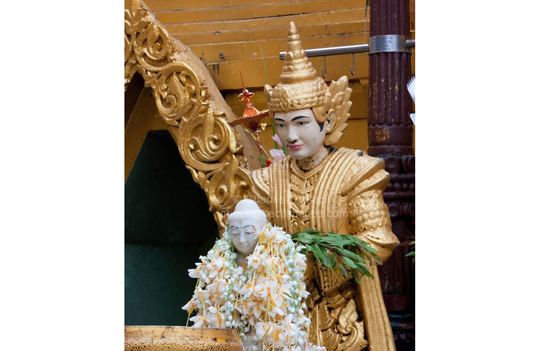
 Garuda, Mural, Ananda Ok Temple, Bagan, Myanmar Pic by Benoy K Behl.
Garuda, Mural, Ananda Ok Temple, Bagan, Myanmar Pic by Benoy K Behl.
This separation of Hinduism from Buddhism in India
seems more like politics. Why Ambedkarites dislike Hindus needs a separate
article. Read British
policy was to divide Hindus by caste
Nevertheless
it is sufficient to recall what former President Scholar Dr S. Radhakrishnan
wrote in Indian Philosophy Volume 1, "The 4 noble truths of Buddhism correspond to the 4 truths of Samkhya as put in the Samkhyapravacanabhasya: “1. That from which we deliver ourselves in pain. 2. Deliverance is the cessation of pain. 3. The cause of pain is the want to discrimination between prakrti and purusa, which produces the continuous union. 4. The means of deliverance is discerning knowledge.” (399)
Addressing The Parliament of Religions in 1893 Swami Vivekananda said, “I am not a Buddhist, as you have heard and yet I am. If China, or Japan, or Ceylon follow the teachings of the Great Master, India worships him as God incarnate on earth. The relation between Hinduism (by Hinduism, I mean the religion of the Vedas) and what is called Buddhism at the present day is nearly the same between Judaism & Christianity.” Read Swamiji
full speech on subject
Our Constitution
has its origin in colonial thinking and is probably ignorant of the deep
connects that bind Indic faiths and culture. It works on the undefined concepts like minority.
Read, reflect and decide for yourself. eSamskriti
is grateful to the learned for sharing their knowledge and pictures.
Also read
1. Lord Indra in Buddhism
2. Six Days of Indic heritage in
Cambodia
3. Ambedkar erred, Buddha was a
Hindu
4. Historical Ties between India and
Thailand by Cultural Attache to Thai Consulate Mumbai.